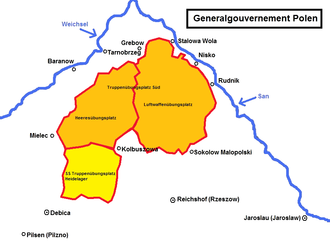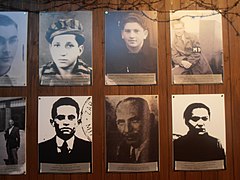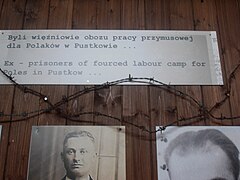SS military training area at Heidelager
The SS military training area in Heidelager was in the “Województwo podkarpackie” ( Subcarpathian Voivodeship ). The next larger town is Dębica , after which the practice area was named.
location
The military area was located in the triangle of the Vistula and San rivers . The area is dominated by large forest areas. The area around Kolbuszowa with other villages next to the city is not included. In the area of the military training areas there were or are several small village settlements, which were certainly cleared when the training areas were set up. The center of the "Heidelager" was near Blizna .
history


The military area was established near Blizna on June 26, 1940 , after the Polish residents were forcibly evicted and the villages had already been destroyed. The facility was based on an order from RFSS Heinrich Himmler . This issued the order with reference to the order of OKW No. 3032 of December 21, 1939, which provided for the establishment of an SS military training area in the area east of Debica in the Generalgouvernement of Poland. The SS military training area underwent several name changes. In the planning, it operated from December 21, 1939 to June 26, 1940 as the SS military training area "Eastern Poland". When the actual construction of the square began on June 26, 1940, it was renamed the “Debica” SS military training area. From March 15, 1943, the site was called the "Heidelager" SS military training area.
The practice area was set up as a barrack camp with four ring roads (called Camp Flanders ). It should be completed on October 1, 1940 for two reinforced infantry regiments. In fact, he could only be used for combat and unit training in the spring of 1941. The exercise area was planned and built by the SS main office “Household and Buildings”. An SS internal troop store for goods and food ensured supplies for SS troops. From October 1941, a prison camp for Soviet prisoners of war was planned on the site. It is not known whether and how this camp was implemented. How many Nazi forced laborers were used to build the square has not yet been conclusively clarified.
A camp was set up in Pustkow eight kilometers southwest of Blizna. A total of 5,000 Russian prisoners, 7,500 Jews and 2,500 Poles were killed there or at work in the Heidelager.
Between November 1943 and July 1944, 139 A4 rockets (V2) were launched on the training area for test purposes without warheads and for the purpose of training the starting crews, mainly in a north-easterly direction, in order to descend in the area of the military training area south of the Wehrmacht , which is adjacent to the SS military training area Heidelager . After the air raids on Peenemünde it was decided not to train the rocket troops and test the A4 missiles in Peenemünde, but in southeastern Poland outside the range of the Allied bombers.

After the bombing of Peenemünde in October 1943, the training and test battery 444 was moved to this military training area, which carried out further test starts under field conditions with the unit 4. The operating teams for field starts on the western front were also trained there.
Polish partisans observed and photographed the take-offs and reported them to London. On May 20, 1944, members of the Polish Home Army seized parts of a crashed A4. The most important parts, together with the evaluations carried out in Poland, were flown to Brindisi on the night of July 25th to 26th, 1944 with a DC-3 of the RAF , which had landed near Żabno ( Operation Most III ). From there the parts came to London. For the first time, parts of the V2 came into the hands of the Allies. After 1990 a memorial for the action and the partisans was erected at the site.
Nevertheless, A4 rockets were still launched for test purposes in Peenemünde until February 21, 1945. Since the rockets launched from the SS military training area - in contrast to the rockets launched from Peenemünde - flew over inhabited land, structures were also destroyed. In July 1944, due to the approaching Soviet troops, start-up activities at the training area had to be suspended and relocated to the West Prussian SS training area in the Tucheler Heide.
After the clearance of the Heidelager SS military training area in the summer of 1944, the area is said to have been defended by a Waffen-SS combat group led by an SS-Hauptsturmführer for several days before the remnants of the combat group with the wounded managed to break out on trucks . When the training area was cleared, the entire camp was destroyed by fire.
Because of the crimes committed at the military training area, Polish individuals and the Main Commission for Research into Hitler's Crimes in Poland filed criminal charges from 1959 onwards. There were extensive investigations in Germany, in which an attempt was made to clarify the crimes on the military training area and in the Jewish forced labor camp in Pustkow.
today
At Blizna part of the camp was rebuilt and a tourist center with memorial places etc. was set up. Remnants such as bunkers, launch sites and building foundations can be viewed.
The same applies to the prisoner or concentration camp in Pustkow.
On the former training area north of Blizna there is a closed military area of the Polish army .
photos
literature
- Władysław Góra (Ed.): Wojna i okupacja na ziemiach polskich 1939–1945. Wydawnictwo Książka i Wiedza, Warszawa 1984, ISBN 83-05-11290-X .
- Moritz Pfeiffer: My grandfather in the war 1939–1945. Memory and facts in comparison (= History & Peace series. Vol. 18). 3. Edition. Donat, Bremen 2013, ISBN 978-3-943425-02-4 , p. 156 ff.
Web links
- Heidelager (Polish and English)
- Blizna
- Link to a historical map of the training area (southern part), as of 1944
- Link to a historical map of the training area (northern part), as of 1944
Individual evidence
- ↑ ForgottenCamps , JewishGen.org, accessed March 1, 2015
- ^ Jan Erik Schulte : Forced Labor and Destruction: The Economic Empire of the SS. Oswald Pohl and the SS Economic Administration Main Office 1933–1945. With a foreword by Hans Mommsen . Schöningh, Paderborn et al. 2001, ISBN 3-506-78245-2 (at the same time: Bochum, University, dissertation, 1999).
- ^ Jan Erik Schulte: Forced Labor and Destruction: The Economic Empire of the SS. Oswald Pohl and the SS Economic Administration Main Office 1933–1945. With a foreword by Hans Mommsen. Schöningh, Paderborn et al. 2001, ISBN 3-506-78245-2 (at the same time: Bochum, University, dissertation, 1999).
- ↑ Information at the memorial site
- ↑ Ruth Kraft: Island without a beacon. Berlin 1959
- ↑ Melanie Hembera: Investigation and prosecution of Nazi crimes against prisoners in the Jewish forced labor camp in Pustków , pdf, Federal Archives, accessed March 1, 2015
- ↑ https://www.google.com/maps/views/view/111605648798705679287/gphoto/5724830449882172194?gl=de
Coordinates: 50 ° 12 ′ 6.6 ″ N , 21 ° 32 ′ 11.5 ″ E















